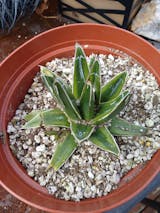Agave Variegated Victoria Reginae are stunning especially as they get larger and more mature. If you love agaves like we do, you gotta consider one of these for your collection. They definately make a statement in decorative pots, or landscaped in the ground.
Check out our other Agave potted and Agave pups pages for lots of other Agaves!
***Agaves have sharp tips and edges, always handle with gloves and open box carefully with gloves!
**Agave tips get bent/broken, especially on the older outside edges naturally in life. As Agaves grow, you'll often trim/cut the older branches/leaves to clean up their appearance and this also allows them to fit better in containers and allows room for new pups to grow and pop out! See pics below. We often cut the tips off our decorative ones in the yard to keep our kid legs and dog noses safe.
Sometimes tips get bent or broken during shipping regardless of how well we pack. We will not refund you or ship out a new Agave simply because some tips are not perfect. We do guarantee the Agaves to be healthy, and any blemishes will be outgrown in their future growth. assuming they are happy in their new conditions!
Here’s some basic Agave info
Agave – Linnaeus (1753)
Greek: agauos = of kings and heros, illustrious, hence noble
Over 300 species of Agave have been described, but only about 200 are currently recognised. Most species are monocarpic, although a few can flower several times during their life. The flowers are “perfect” with both male and female parts. Many species of Agave are bat pollinated and produce musky perfumes as attractants. Others produce sweeter odours to attract insects.
Most Agaves consist of rosettes of thick, hard, rigid but succulent leaves often with marginal teeth and usually with a lethally sharp terminal spine. Prolific vegetative growth and offsetting at the base of the plant or through stolons, usually maintains a clump of plants thus compensating for loss of flowering rosettes. A few species remain solitary, relying on seed production for survival of the species.
The interior of the leaves contains longitudinal fibres representing the vascular system. Agave leaf fibre was used by native Americans. Agave fibre from a range of species is of commercial importance, with the best quality fibre coming from the youngest leaves. Sisal (hemp) made from cultivated Agave sisalana is used to make clothing and rugs.
Carbohydrates stored in the core of several species of Agave were fermented by native Americans to make a beverage called pulque which was used in religious ceremonies. Distillation of a similar ferment made from the developing Agave flower bud is the basis for modern production of Mezcal. Only if made from the Blue Agave within Tequila, Mexico can the distillate be called Tequila.








